Dogs are wonderful companions, but they can also get dirty and smelly from time to time. As a responsible dog owner, you might wonder how often you should bathe your dog to keep them clean and healthy.
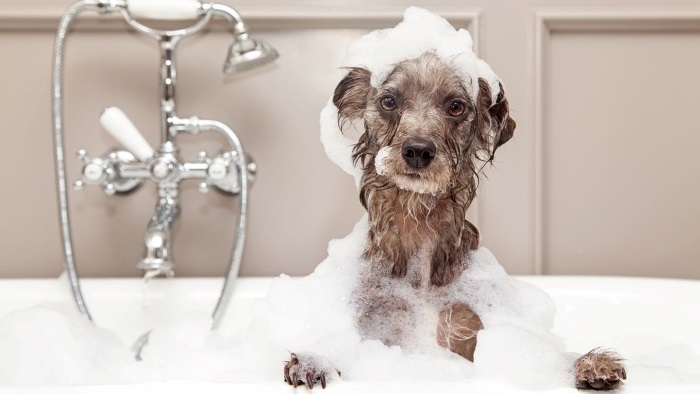
The answer is not as simple as you might think, as it depends on several factors, such as your dog’s breed, coat type, lifestyle, and health condition. In this article, we will explore some of the guidelines and tips for bathing your dog.
Contents
Why Bathing Your Dog Is Important
Washing your dog may help keep them free of allergies, illnesses, and parasites[1], in addition to making them look cleaner and more magnificent.
According to PetMD, “Cleaning your dog’s coat and skin may help remove dirt, debris, dead skin cells, and excess oils that could otherwise harbor bacteria, fungi, and insects.“
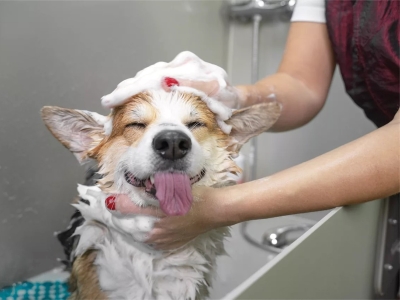
Bathing can also enhance blood circulation, lessen itching[2] and scratching, and soothe inflamed skin[3].
Additionally, washing your dog may help you keep an eye on their skin health and spot any irregularities like lumps, sores, or rashes.
How Often Should You Bathe Your Dog?
Breed
Different breeds have different coat types and lengths that require different levels of care[4].
For example, dogs with smooth, short coats (like Beagles) usually only need bathing every four to six weeks, while dogs with water-repellent coats (like Golden Retrievers) should be bathed less often to preserve their natural oils.
On the other hand, dogs with long–haired or curly coats (like Poodles) may need more frequent baths to prevent mats and tangles.
Lifestyle
Your dog’s requirement for baths might vary depending on their level of activity and exposure to the outdoors.
For instance, dogs that spend a lot of time outside (such as working dogs or hunting dogs) may get dirtier and smellier than dogs that spend most of their time indoors.
Similar to humans, dogs that swim in lakes or pools could require more regular baths to get chlorine or algae out of their fur.
Health Condition
If your dog has any health issues[5] that affect its skin or coat, such as allergies, infections, or parasites, it may need more or less frequent baths, depending on the advice of your veterinarian.
Some skin conditions may require medicated shampoos or special products that can help treat the problem. However, bathing too often can also dry out your dog’s skin and cause irritation or inflammation.
How to Bathe Your Dog Properly
Bathing your dog can be a fun and bonding experience for both of you if you do it right.
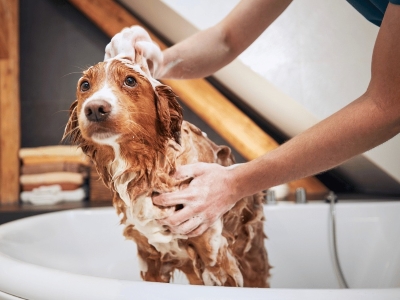
Here are some tips to make bath time easier and more enjoyable:
Choose the right products
Always use a shampoo made exclusively for dogs since human shampoos can have ingredients that are too abrasive or acidic for a dog’s skin.

For advice on the best products for your dog’s coat and skin type, you may also speak with your doctor. Avoid using anything that may irritate your dog’s skin or eyes by containing artificial perfumes, colors, or chemicals.
Prepare the area
Choose a suitable place to bathe your dog, such as a bathtub, a sink, a shower stall, or a hose outside. Make sure the water temperature is lukewarm and not too hot or cold.

You can also place a rubber mat or a towel on the bottom of the tub or sink to prevent slipping. Gather all the supplies you need beforehand, such as shampoo, conditioner (if needed), towels, brushes, combs, scissors (if needed), and treats.
Brush your dog
Give your dog a good brushing before you wet their fur to get rid of any loose hair, dirt, or mats.

This will simplify and improve the bathing procedure. Additionally, if necessary, you may cut any extra hair that is around their eyes, ears, paws, or anus.
Wet your dog
Begin by wetting your dog’s hide from the neck down with a delicate splash or a glass of water.
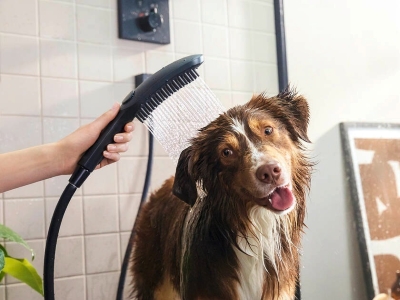
Avoid getting water in their ears, eyes, nose, or mouth. You’ll be able too utilize cotton balls to plug their ears in case they are inclined to ear contamination.
Apply shampoo
Squeeze a small amount of shampoo onto your palm and lather it into your dog’s fur. Massage it gently into their skin and coat, avoiding the head area.
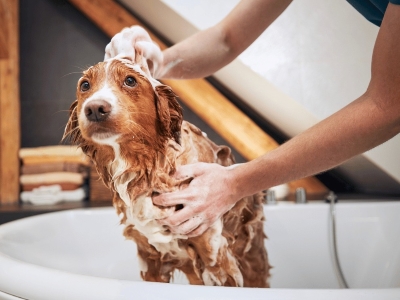
You can use a soft brush or a sponge to help distribute the shampoo evenly. Rinse thoroughly with clean water until no suds remain.
Wash the head
Wipe your dog’s face, ears, and eyes with a moist cloth or sponge. Avoid very vigorous rubbing or getting shampoo in their eyes.
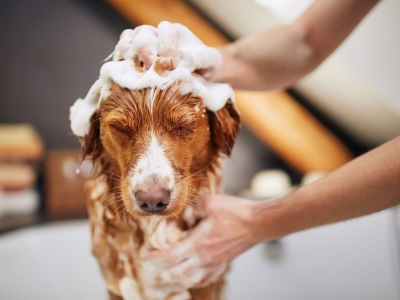
If necessary, you may also clean their eyes with a special eye wash or a tearless shampoo.
Dry your dog
If your dog is at ease with it, you can use a hair dryer on a low setting while gently patting your dog dry. When your dog’s fur is damp, avoid rubbing or brushing it since this might lead to breaking or injury.
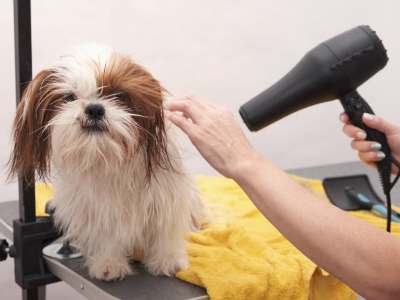
If necessary, you may also moisturize or condition your dog’s coat.
Reward your dog
Give your dog lots of praise and goodies after the wash for being such a good sport. To make them joyful and at ease, you may also play with them or give them a hug.

FAQs
Can I bathe my dog too often?
If you bathe your dog too frequently, unnatural oils may be removed from their coat, which can lead to dryness and discomfort. Over-bathing has the potential to alter the skin’s pH balance and do more harm than good. You must find a balance in order to satisfy your dog’s needs.
Are there breeds that require more frequent baths?
Breeds with hair that grows continuously, such as Poodles or Bichon Frises, often need more frequent bathing to maintain their coat’s cleanliness and health. Breeds with oily skin, like Bulldogs, might also require more regular bathing.
Can I use human shampoo on my dog?
It is not advised to wash dogs with human shampoo. Because of the differing pH level that human shampoos are created for, they may be excessively abrasive and drying for a dog’s delicate skin. Always use a mild dog shampoo made specifically for their coat type.
What if my dog has a specific skin condition or medical issue?
It’s crucial to speak with your veterinarian before bathing your dog if they have allergies, a medical condition, or skin conditions. To meet your dog’s unique demands, they can advise you on the best bathing schedule and supplies.
Can I use a waterless or dry shampoo for my dog?
Waterless or dry shampoos can be a convenient option between regular baths, especially for dogs that dislike water. These products can help freshen your dog’s coat, but they shouldn’t replace proper bathing entirely.
Conclusion
A crucial component of preserving your dog’s health and happiness is giving them a bath. The breed, coat type, lifestyle, and state of health of your dog all play a part in how frequently you should bathe them.
In general, you should bathe your dog every one to three months, or anytime they get stinky or unclean. Making bath time a joyful and enjoyable experience for both of you also requires the use of the appropriate items and methods.
If you have any questions or worries regarding the necessity of bathing your dog, never hesitate to contact your veterinarian.
Reference:
- Internal Parasites in Dogs | VCA Animal Hospital
- 5 natural remedies to help your itchy dog | PetMD.
- Pruritus – itching and scratching in dogs | VCA Animal Hospital
- Grooming and coat care for your dog | VCA Animal Hospitals. (n.d.). Vca.
- 25 Popular dog breeds and their health problems. (n.d.) | WebMD.

Dania is a dog groomer living in California, who loves styling dogs. She often uses dog accessories to keep them distracted while grooming. She is also a dog parent to a Pomeranian, Duke. It’s because of him she is always on a lookout for the best dog foods, toys, other dog accessories, and ways to keep him equipped, healthy and happy.


